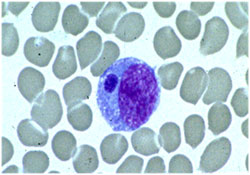Ehrlichia chafeensis (HME), Ehrlichia ewengii and Anaplasma phagocytophilum(HGE), are emerging zoonotic diseases, especially in areas where human urban living encroaches on endemic tick areas. These bacteria are largely found in mammals residing in the southeastern, south-central, and mid-Atlantic areas of the United States, and according to the CDC, most cases are reported in the states of Maryland, Arkansas, Missouri, Oklahoma, and Tennessee. Ehrlichia and Anaplasma bacterias have also been noted in Brazil, the United Kingdom, France, Slovenia, Switzerland, Germany, the Netherlands, Spain, Russia, and Japan. However, similar to other tick-borne diseases, migratory birds probably play a significant role in disease spread around the globe, and these bacteria (HGE and HME) are likely found in other areas of the world not yet identifying and reporting the disease. Of note, Ehrlichia in particular is known to be a veterinary disease largely seen in horses and dogs.
Ehrlichia and Anaplasma are intracellular obligate bacteria that require a host for replication and a vector for transmission (i.e., ticks). Human signs and symptoms of these diseases are often not accompanied by a “Bullseye rash”, however, there may be redness and heat at the site of the tick bite. HME or HGE illness can occur quickly (depending on the number of bacteria delivered to the host at the bite site), or it can develop more slowly over time as the bacteria replicate and proliferate in the host. Generally, clinically presenting symptoms can include fever, stiff neck, joint pain, muscle aches, headache, chills, malaise, nausea, and diarrhea. Elevated serum liver enzymes including ALT and AST may also occur, lending clues to the underlying bacterial infection in question.
HGE and HME are serologically diagnosed using antibody titer tests or by using PCR (polymerase chain reaction) which demonstrates the presence of bacterial DNA in the blood and therefore exposure to the bacterias that cause Ehrlichiosis. Careful determination of these bacterial infections is important because the presence of Rocky Mountain Spotted Fever, Brucella, Typhus, and Q fever (also zoonotic diseases) can cause false-positive serology for Ehrlichia.
Occasionally, these infections can require hospitalization, especially for pain management which results from the activation of acute and prolonged pro-inflammatory cytokine release and tissue damage due to the host’s immune system activation.
An integrated medicine treatment approach to Ehrlichia and Anaplasma infections, where a combination of immune-supportive herbs, anti-inflammatories, and antibiotics in rotation, are recommended and generally yield favorable outcomes. However, not unlike the other tick-borne infections, when the infection(s) are diagnosed early (less than 12 months from the time of the tick bite) prior to dissemination throughout the body, a return to health is maximized.
In the next decade, cutting-edge research on genomics, proteomics, and the cellular microbiology of these bacterial infections is likely to reveal additional therapeutic agents (i.e., herbal, nutritional, and pharmacological). Future therapeutic interventions may focus on disengaging adhesin molecules that bind to white blood cells, which interfere with the replication and proliferation of these bacteria in the host. Around the world, more and more researchers are becoming interested in developing effective new therapeutics for eradicating these diseases.


